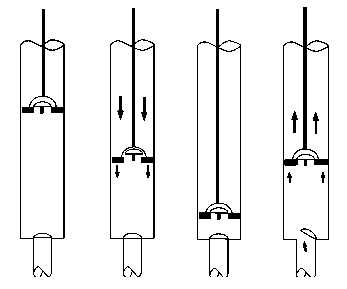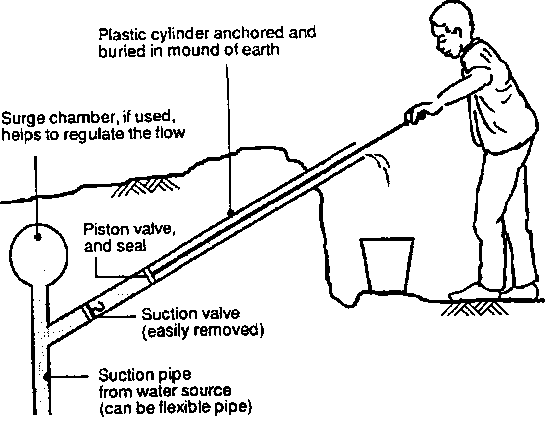Comment fabriquer une pompe à main : Différence entre versions
| Ligne 1 : | Ligne 1 : | ||
| − | + | La plupart des types de pompe à eau souterraine ont un piston qui va et vient dans un cylindre à deux soupapes (une vanne laisse passer l'eau dans une seule direction - dans ce cas, vers le haut): | |
Suction pumps have the cylinder situated above ground or near the surface. This means that they can only be used for shallow wells. It is called a suction pump because pulling up on the piston creates a low pressure ("suction") in the cylinder, causing the atmospheric pressure outside to push the water up to the surface. Because atmospheric pressure is fairly low, the pressure difference between inside and outside the cylinder is only large enough to raise water from a maximum depth of about 7 metres. | Suction pumps have the cylinder situated above ground or near the surface. This means that they can only be used for shallow wells. It is called a suction pump because pulling up on the piston creates a low pressure ("suction") in the cylinder, causing the atmospheric pressure outside to push the water up to the surface. Because atmospheric pressure is fairly low, the pressure difference between inside and outside the cylinder is only large enough to raise water from a maximum depth of about 7 metres. | ||
Version du 25 mars 2014 à 19:41
La plupart des types de pompe à eau souterraine ont un piston qui va et vient dans un cylindre à deux soupapes (une vanne laisse passer l'eau dans une seule direction - dans ce cas, vers le haut):
Suction pumps have the cylinder situated above ground or near the surface. This means that they can only be used for shallow wells. It is called a suction pump because pulling up on the piston creates a low pressure ("suction") in the cylinder, causing the atmospheric pressure outside to push the water up to the surface. Because atmospheric pressure is fairly low, the pressure difference between inside and outside the cylinder is only large enough to raise water from a maximum depth of about 7 metres.
It should also be noted that if a shallow-well is used too much, the water-table may fall as the underground reservoir of water is reduced. If this level falls below 7 metres, the pump will not work.
Four types of shallow-well pumps are shown below: rower, piston, diaphragm and semi-rotary.
Sommaire
Rower
The rower pump is a simpler and cheaper version of the traditional piston pump (see below). Its simple design means it can be easily manufactured and maintained using locally available skills and materials. This type of pump may require "priming", which means pouring water into the cylinder so that the seal around the piston is airtight. It is very important that clean water is used, to avoid contamination of the pump and the spread of water-borne diseases.
Piston
Piston pumps, based on the same design as shown in Figure 1, are more widely used. There is a similar risk of contamination from dirty priming water. In cases where the water is to be delivered under pressure (such as to a village water mains) or to a point higher than the cylinder (such as a water storage tank), a "force" pump is required. The operation is the same, but the design is slightly altered so that the top is airtight. This is done by putting a valve on the spout and adding a "trap tube" and air chamber which maintains the pressure (and therefore the flow) during the up-stroke.
Diaphragm
This design is often used for fuel pumps in cars. The Vergnet pump is an adaptation of this principle for deep-well use, which can be used in crooked wells, where a rod-operated pump would have problems, and which is fairly easy to maintain.
References and further reading
This Howtopedia entry was derived from the Practical Action Technical Brief man-Powered Water-Lifters.
To look at the original document follow this link: http://www.practicalaction.org/?id=technical_briefs_water
Related Articles
- How to Build Human-Powered Water-Lifters
- How to Build an Underground Brick Dome Water Tank
- How to Make a Hand Pump
- How to Make a Solar Pump
- How to Make a Hydraulic Ram Pump
- How to Build a Windpump (Principles)
- How to Use Diesel Engines
- How to Use Photovoltaic Energy
- How to Use Sun Power
- How to Use the Porous Clay Pots and Pipes System
- Micro Irrigation
Soutenez le travail d’Howtopedia, aidez-nous à continuer à écrire et à traduire plus d'articles pratiques sur des technologies simples!
<paypal />



